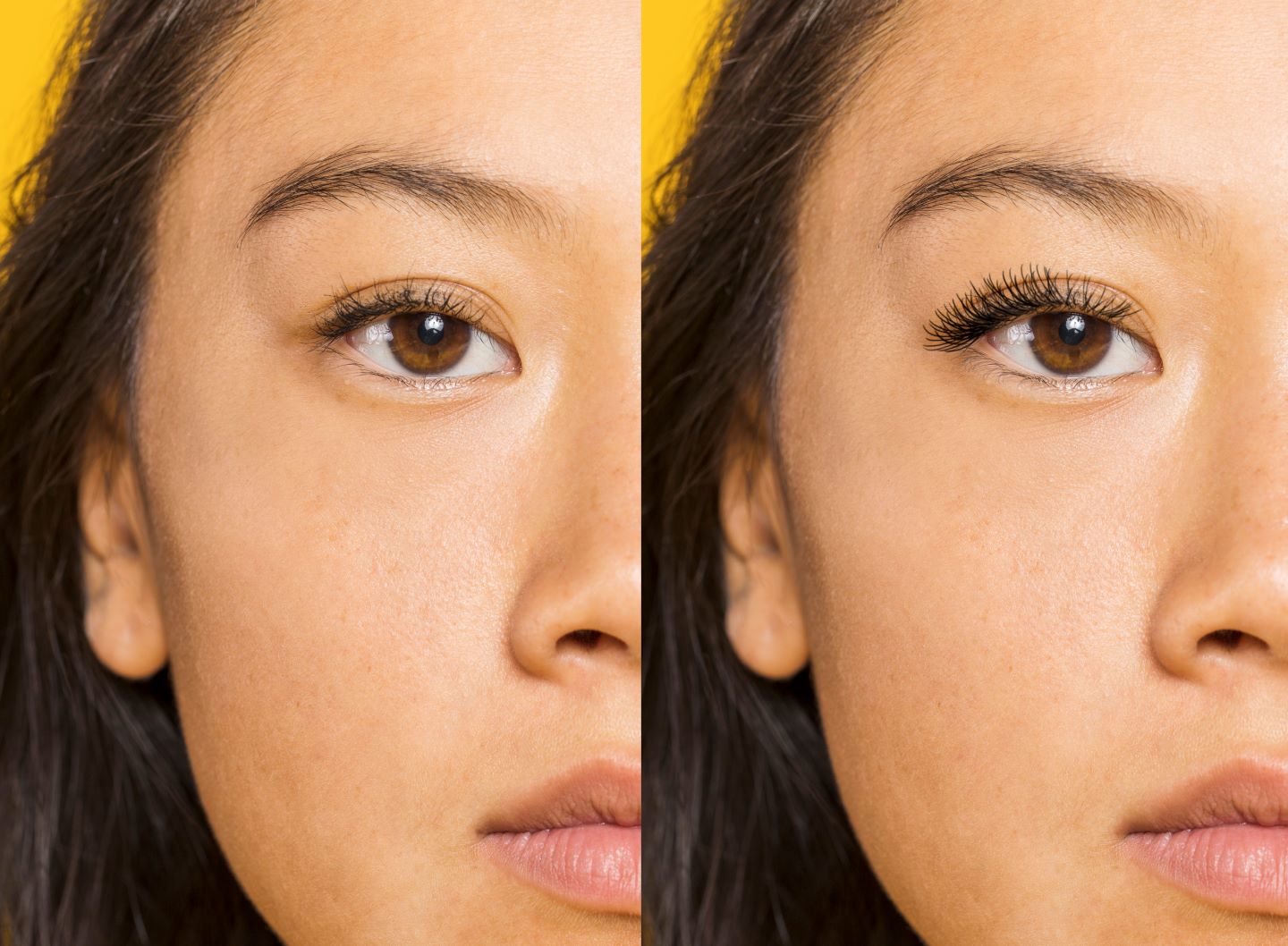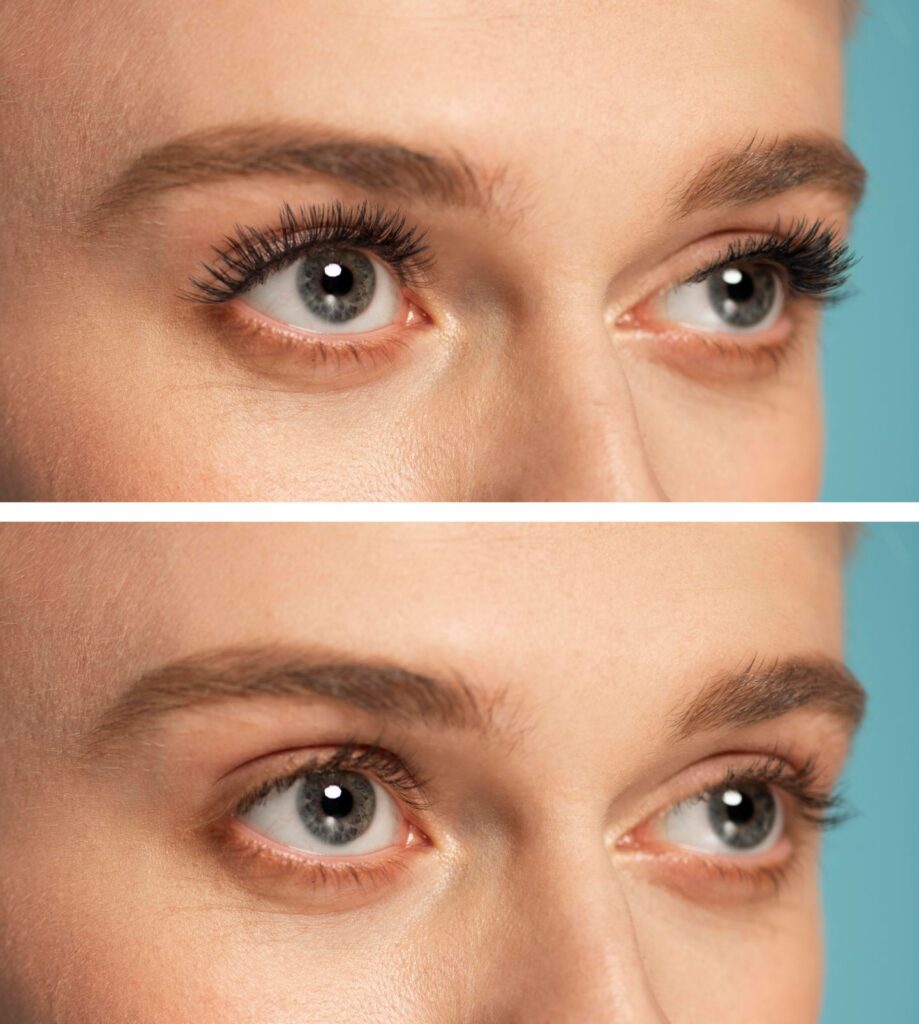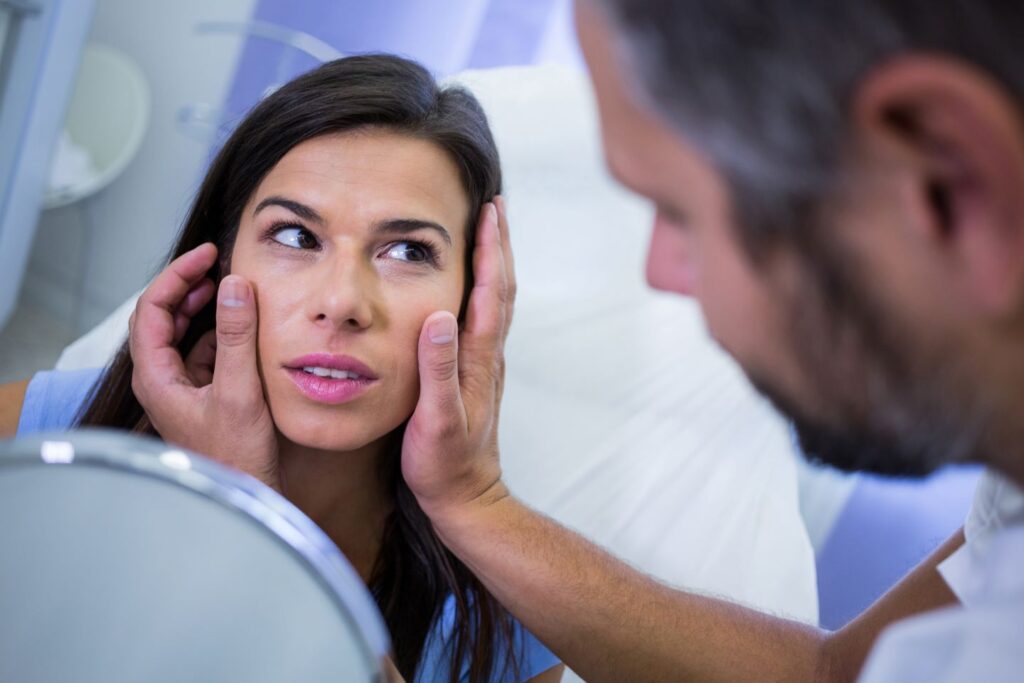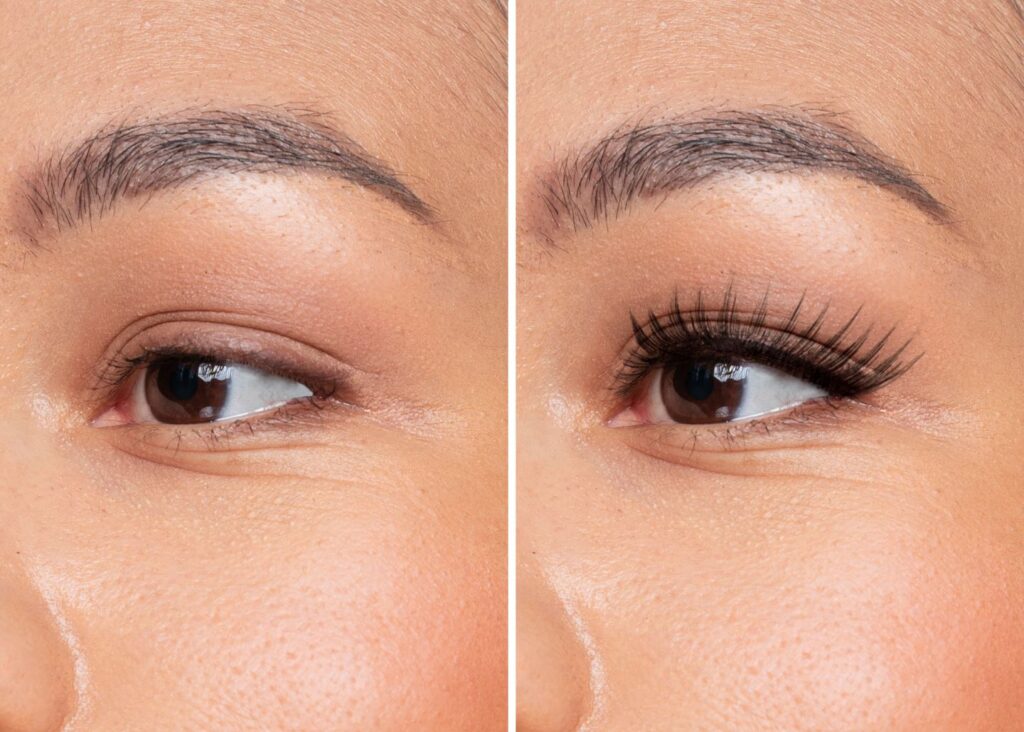Upper Blepharoplasty Before and After: Risks, Photos and Aftercare

Upper Blepharoplasty Before and After
Eyelid surgery, or upper blepharoplasty, is a cosmetic operation used to improve the appearance of the upper eyelids. The procedure’s primary goal is to remove extra skin, muscle, and fat that can build up over time and cause the eyelids to droop or sag. Upper blepharoplasty patients can see remarkable changes in their appearance before and after the procedure and functional issues associated with impaired eyesight.
Before Upper Blepharoplasty: Understanding the Concerns
Before deciding to get an upper blepharoplasty, people frequently deal with typical functional and cosmetic problems brought on by aging, heredity, or environmental causes. The fragile texture of the skin around the eyes makes the top eyelids more vulnerable to indications of aging.
- Sagging and Excess Skin: One of the main issues is accumulating extra skin on the upper eyelids, which can give the illusion of being hooded or drooping. This may provide the eyes with a worn-out, old appearance.
- Fat Deposits: As fat builds up in the upper eyelids over time, it can cause puffiness and a less distinct crease in the eyelid.
- Muscle Weakness: As we age, the muscles that support our eyelids may weaken, losing some of their rigidity and causing our eyelids to droop.
- Functional Impairments: Vision obstruction is one functional impairment that may arise from upper eyelid drooping. This may have an impact on day-to-day activities and general well-being.
The Upper Blepharoplasty Procedure: What to Expect
A surgical technique called upper blepharoplasty tries to solve these issues and give the appearance of more rejuvenation. The procedure, which is usually done as an outpatient, entails the following crucial steps:
- Anesthesia: Depending on the patient’s choices and the surgeon’s advice, the procedure is typically performed under general or local anesthesia with sedation.
- Incision: The surgeon meticulously arranges and makes incisions along the upper eyelids’ natural creases to reduce noticeable scarring. The positioning of these incisions is essential to getting an outcome that looks natural.
- Tissue Adjustment: Next, extra skin, muscle, and fat are cut off or shifted about to give the contours a smoother, younger appearance. To enhance the general support of the eyelids, the underlying muscles may be made tighter.
- Closure: The wounds are painstakingly sealed with tiny sutures for the best possible recovery. Scarring can be reduced mainly by the surgeon’s competence and suture selection.

After Upper Blepharoplasty: The Transformation
Following upper blepharoplasty, there is frequently a noticeable change with practical and cosmetic advantages. Although the precise outcomes can differ from person to person, the following common alterations are usually noticed:
- Removal of Extra Skin: Removing extra skin from the upper eyelids is the most noticeable improvement. This gives the appearance of being raised and a more pronounced eyelid crease.
- Better Contour: The upper eyelids have a smoother, younger-looking contour due to the removal or realignment of fat deposits. Less puffiness gives the eyes a more rested appearance.
- Improved Eye Shape: The procedure can improve the eyes’ natural form, giving the impression that they are wider open and more attentive. This makes the entire facial expression seem younger and more lively.
- Functional Benefits: Following the operation, many patients report having better vision and a wider field of vision. Sagging eyelids can cause operational problems that can be alleviated by removing obstructive skin.
- Boost in Confidence: The psychological effects of an upper blepharoplasty are noteworthy, even apart from the physical ones. Patients who feel more comfortable and content with their appearance frequently report higher confidence and self-esteem.
Rehab and Aftercare: Advice for the Best Outcomes
Following upper blepharoplasty, patients have a relatively quick recovery period; however, they must adhere to the postoperative recommendations given by their surgeon. Important pointers for the best possible recovery include:
- Relaxation: Sufficient rest is necessary for a speedy recovery. In the early days following surgery, patients are recommended to refrain from physically demanding activities and significant eye strain.
- Cold Compresses: Using cold compresses can aid in the reduction of bruises and swelling. This is usually advised in the initial days following surgery.
- Medication Management: Administer painkillers and any recommended antibiotics according to the directions. This lowers the chance of infection and helps control discomfort.
- Eye Protection: During the early phases of their recovery, patients are frequently advised to wear sunglasses to shield their eyes from the sun and outside factors.
- Follow-up Sessions: To track the healing process, scheduling routine follow-up sessions with the surgeon is imperative. To guarantee the best outcomes, any worries or problems can be quickly resolved.
Potential Risks and Considerations
Even though upper blepharoplasty is typically regarded as a safe operation with a high satisfaction rate, people should be aware of possible hazards and concerns. These could consist of:
- Scarring: Some scarring is unavoidable despite best efforts to position incisions in wrinkles found naturally. However, scars are generally small and dissolve with time with appropriate care and the use of sophisticated surgical procedures.
- Asymmetry: It is difficult to achieve absolute symmetry, and minor asymmetries may continue following surgery. Expert surgeons work to reduce any discernible variations between the two eyelids.
- Complications: Upper blepharoplasty poses several dangers, similar to any surgical procedure: bleeding, infection, and anesthesia-related unpleasant reactions. Careful patient screening and strict adherence to safety procedures reduce these hazards.
- Dry Eyes: After surgery, some patients may suffer a brief sensation of dryness or irritation in their eyes. Usually transient, this is treatable with prescribed eye treatments.
- Long-Term Outcomes: Although upper blepharoplasty produces effects that last for a long time, aging still occurs. Various factors, including sun exposure, lifestyle choices, and genetics, can influence the results’ longevity.

Upper Blepharoplasty Cost
The complexity of the treatment, the surgeon’s experience level, the location, and whether or not other procedures are carried out concurrently can all significantly impact the cost of an upper blepharoplasty. The following provides a broad summary of the variables that affect the price and what to anticipate:
Expertise and Reputation of the Surgeon:
Cosmetic surgery specialists with excellent knowledge and a stellar reputation typically charge more. For many patients, the extra expense may be justified by their competence, which can increase their confidence in attaining the intended aesthetic results.
Location:
The price of an upper blepharoplasty can differ significantly depending on where you live. Generally speaking, procedure costs in big cities or higher-priced locations are higher than in less expensive areas.
Facility Fees:
Hospitals, surgical centers, and private surgical suites are just a few locations where the procedure can be carried out. The total cost of the process will consider the various associated charges for each type of facility.
Anaesthesia Fees:
The price of anesthesia is an additional factor to consider. The cost will vary depending on whether general or local anesthesia with sedation is used for the surgery. The costs are typically higher because general anesthesia requires a nurse anesthetist or an anesthesiologist.
The complexity of the Procedure:
Depending on the specifics of the operation, such as the degree of correction required, whether fat removal or repositioning is necessary, and whether the upper and lower eyelids are being treated, the cost may vary. More intricate operations that take longer to complete will cost more money.
Extra Procedures:
Patients may get brow lifts, facelifts, or lower blepharoplasty concurrently with other cosmetic procedures. While combining operations can occasionally result in lower overall costs than performing each separately, the surgical session cost will increase overall.
Average Cost:
The average cost of an upper blepharoplasty in the US can be anywhere from $3,000 to $5,000. The surgeon’s charge is usually the only expense included in this range. The sum may increase if anesthesia, facility fees, and other related expenses are considered. It’s vital to remember that these costs could have changed after my last update and are subject to change.
Insurance Considerations:
Insurance may pay for all or part of the upper blepharoplasty operation if it is determined that the procedure is medically required, such as when extra skin on the eyelids obstructs vision. However, insurance usually does not cover procedures done purely for aesthetic purposes. To learn more about their choices for coverage, patients should speak with their surgeon and insurance company.
Consultation Is Crucial:
Due to the wide range of expenses, patients considering upper blepharoplasty should see many board-certified plastic surgeons to obtain comprehensive estimates covering all related charges. Surgeons can provide tailored prices during these consultations based on the patient’s unique demands and objectives, enabling a more precise estimate of the possible expenses.
Blepharoplasty Near me: Locate a Reliable Blepharoplasty
Try doing the following to identify a reliable blepharoplasty surgeon in your area:
Board Certification Search:
Look for locally practicing board-certified oculoplastic or plastic surgeons to start. The surgeon’s adherence to strict practice guidelines and extensive training are guaranteed by board certification. To find oculoplastic surgeons in the US, check out the American Society of Ophthalmic Plastic and Reconstructive Surgery (ASOPRS) or the American Board of Plastic Surgery (ABPS). Find the appropriate national board or group that accredits plastic surgeons in other countries.
Local Hospital Affiliations:
Look for surgeons with connections to respectable local hospitals or clinics. These connections frequently suggest that the surgeon satisfies the hospital’s requirements for high-quality care.
Online Testimonials and Reviews:
Examine prospective surgeons by reading patient endorsements and reviews. Websites that offer information about patient happiness and results include RealSelf, Healthgrades, and Google Reviews. But remember that these reviews cannot always give you the whole picture, so proceed cautiously.
Surgeon’s Website and Portfolio:
Check out the before-and-after photo portfolios by visiting the surgeons’ official websites. This can help you understand their aesthetic preferences and possible outcomes. To assess a surgeon’s skill in blepharoplasty, look specifically for pictures of previous patients.
Consultation Sessions:
Discuss your expectations and aspirations with a few surgeons during consultation sessions. This is your chance to learn about their background, the treatment, the healing process, and whether or not their demeanor and care method make you feel at ease.
Ask About Technique and Technology:
During your consultation, please learn about the physicians’ treatments and whether they keep up with the most recent developments in blepharoplasty technology. This signifies their dedication to giving patients the best treatment possible.
Assess Communication and Comfort:
The surgeon must be able to answer your questions, put you at ease, and communicate well. You ought to believe in their skills and feel at ease with their support system.
Cost and Logistics:
Talk about the price, possible payment methods, and the specifics of the surgery, including the location and the kind of postoperative care. Making an informed decision can be aided by being aware of these factors.
Insurance and Accreditation:
Ensure the surgeon takes your insurance if your blepharoplasty is deemed medically necessary. Make sure the surgical facility satisfies safety criteria by verifying its accreditation.

Conclusion: Upper Blepharoplasty Before and After
With its remarkable before and after outcomes, upper blepharoplasty has grown in popularity as a successful cosmetic treatment. Beyond the cosmetic benefits, the procedure also considers practical issues, making it a worthwhile choice for people whose sagging eyelids obstruct their eyesight.
The choice to have an upper blepharoplasty is very personal, and before making the decision, people should carefully examine their goals, expectations, and any dangers. It is essential to seek the counsel of a board-certified plastic surgeon with eyelid surgery experience to receive personalized guidance, accurate information, and the desired outcomes.
In the end, upper blepharoplasty provides a way to improve overall face harmony and confidence in addition to revitalizing the eyes and supporting ocular health. A person’s perspective on life can be positively impacted by the transformational journey from before to after, which involves more than simply physical changes. It also consists of restoring a sense of youthfulness and vigor, contributing to aesthetic satisfaction and overall health.





